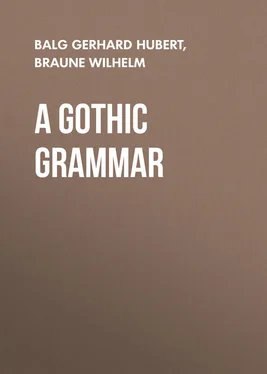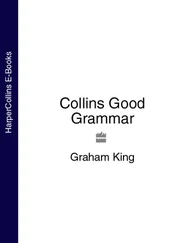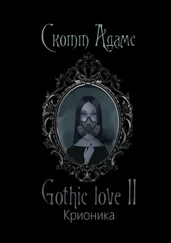Gerhard Balg - A Gothic Grammar
Здесь есть возможность читать онлайн «Gerhard Balg - A Gothic Grammar» — ознакомительный отрывок электронной книги совершенно бесплатно, а после прочтения отрывка купить полную версию. В некоторых случаях можно слушать аудио, скачать через торрент в формате fb2 и присутствует краткое содержание. Жанр: foreign_antique, foreign_prose, на английском языке. Описание произведения, (предисловие) а так же отзывы посетителей доступны на портале библиотеки ЛибКат.
- Название:A Gothic Grammar
- Автор:
- Жанр:
- Год:неизвестен
- ISBN:нет данных
- Рейтинг книги:3 / 5. Голосов: 1
-
Избранное:Добавить в избранное
- Отзывы:
-
Ваша оценка:
- 60
- 1
- 2
- 3
- 4
- 5
A Gothic Grammar: краткое содержание, описание и аннотация
Предлагаем к чтению аннотацию, описание, краткое содержание или предисловие (зависит от того, что написал сам автор книги «A Gothic Grammar»). Если вы не нашли необходимую информацию о книге — напишите в комментариях, мы постараемся отыскать её.
A Gothic Grammar — читать онлайн ознакомительный отрывок
Ниже представлен текст книги, разбитый по страницам. Система сохранения места последней прочитанной страницы, позволяет с удобством читать онлайн бесплатно книгу «A Gothic Grammar», без необходимости каждый раз заново искать на чём Вы остановились. Поставьте закладку, и сможете в любой момент перейти на страницу, на которой закончили чтение.
Интервал:
Закладка:
Note 3. In Latin orthografy aíis exprest by e; e. g., Ermanaricus = Goth. *Aírmanareiks, Ermenberga = Goth. *Aírminbaírga. Cp. Wrede, 'Ostg.', 162.
Note 4. aiis to be regarded as a difthong ( ái) in baitrs, bitter ; jains, yon, that (and its derivations), while formerly, according to OHG. bittar, jenêr, it was thought to be short ( aí). Cp. Holtzmann, 'Altd. Gr.', p. 11 et seq.; Brgm., I, 392; Bezzenb. Beitr., 16, 156. – Scherer (Zur Gesch. d. dtsch. Sprache) presumed short aíalso in the 3d pers. sg. prs. opt. (like nimai) and in several forms of the strong inflection of adjs. (nom. pl. m. blindai, gen. sg. f. blindaizôs, gen. pl. blindaizê, blindaizô). Hirt (Beitr., 18, 284 et seq.) goes stil farther in this direction. – Cp. also § 22, n. 3.
§ 21. II. The old Difthong ai. By far the greater number of the Gothic ais express a difthongal sound which is equivalent to OHG. ei or ê (ahd. gr., §§ 43. 44), OS. ê, ON. ei. The Goths of Wulfila's time indeed seem to hav stil pronounced this aias a+ i. – For the difthong aiwe employ Grimm's sign áiwhenever it is likely to be confused with aí. Exampls of difthongal ai(before h, r, cp. § 20, n. 2): The prts. sg. of the I. ablaut-series ( § 30), — bait, I bit (inf. beitan); staig, I mounted (inf. steigan); etc.; wait( § 197); ains, one ; hlaifs, ( loaf of ) bred ; staiga, path ; laisjan, to teach ; — haitan, to be calld ; maitan, to cut ; skaidan, to separate ; aiws, time ; — hails, hale , sound ; dails, deal .
aiappears also in inflectional syllabls of the III. Weak Conjugation ( § 191): habais, habaida, etc.; in the prs. opt.: nimais, etc.; anstais, gen. sg. of the i-decl.; in the str. adjs.: blindaizôs, etc. ( § 123); – final: gibai, anstai, dat. sg.: nimai, 3 prs. sg. opt.; blindai, dat. sg. f. and nom. pl. m. of the str. adj.; – monosyllabls: þai, nom. pl., these ; twai, 2 ; bai, both ; jai, yes ; sai, behold! ; wai, woe!
Note 1. Latin writers express the Gothic aipredominantly by ai, ei: Dagalaiphus, Gaina, Radagaisus, Gisaleicus(cp. Dietrich, 'Ausspr.'), eilsin a Lt. epigram (Zs. fda., 1, 379). On the Bukarest rune-ring (cp. § 221 Конец ознакомительного фрагмента. Текст предоставлен ООО «ЛитРес». Прочитайте эту книгу целиком, купив полную легальную версию на ЛитРес. Безопасно оплатить книгу можно банковской картой Visa, MasterCard, Maestro, со счета мобильного телефона, с платежного терминала, в салоне МТС или Связной, через PayPal, WebMoney, Яндекс.Деньги, QIWI Кошелек, бонусными картами или другим удобным Вам способом.
, n. 3) stands hailag(Paul's 'Grundriss', I, 411). – Concerning the difthongal pronunciation of the Gothic ai, cp. especially Wrede, 'Wand.', 95 et seq.; about monofthongization in East Goth., s. Wrede, 'Ostg.', 165.
Note 2. aiand ajinterchange in wai, woe! ; wai-dêdja, evil-doer , and waja-mêrjan, to blasfeme ; in aiws, time , and ajukdûþs, eternity .
§ 22. Many scholars hold that also the aiin the reduplicating ablaut vs. ( § 182) saianand waianis difthongal. This ai, however, stands etymologically for Gothic ê, and its OHG. equivalent is â (not ei): OHG. sâen, wâen (cp. ahd. gr., § 359, n. 3.) The difthong aibefore a vowel would becum aj; hense, *sajan, *wajan. Here aiperhaps has the sound of long æ, i. e. open e representing close e (ê) when followd by a vowel; thus, saian, waian, for sêan, wêan.
Note 1. Before the iof the 3d pers. sg. prs. a jis often found: saijiþ(Mk. IV, 14), saijiþ(II. Cor. IX, 6 in A, for saiiþin B; Gal. VI, 7. 8. in A, for saiiþin B). Before athe joccurs but onse: saijands(Mk. IV, 14). Cp. Beitr. 11, 75 et seq.
Note 2. Here belongs also the isolated faian(Rom. IX, 19, in prs. faianda); but the prs. to the prt. laílôunis lauanrather than laian. Cp. Beitr. 11, 56.
Note 3. Also the aiin armaiô, alms (Bezzenb. Beitr. 7, 210; Beitr. 11, 74), is likely to belong here. – Concerning the fonetic values of the ais discust here, cp. especially Beitr. 11, 51 et seq.; Brgm., I, pp. 126. 127; Wrede, 'Wand.' 99, who, beside Holtzmann, is inclined to assume a long sound for these ais; Noreen, 'Urg. Lautlehre', p. 35 et seq.
§ 23. That the Goth. aimay be both short and long (like a in E. at, fare) is evident from its regular occurrence in Greek words. As a rule, ai= ε in aikklêsjô, ἐκκλησία; Aileisabaiþ, Ἐλισάβεθ; Baiailzaibul, Βεελζεβούλ; Gainnêsaraiþ, Γεννησαρέτ, etc.; likewise = αι (i. e. long æ): Idumaia, Ἰδουμαία; Haíbraius, Ἑβραῖος; hairaísis, αἵρεσις, etc.
Note. Gothic aifor Greek η is exceptional; e. g., Hairodiadins, gen. to Ἡρωδίας (Mk. VI, 17); Neikaúdaimus(Skeir. 52); Νικόδημος (for Nikaúdêmuselsewhere.)
au
Also Goth. au(like ai) stands for historically and fonetically different sounds.
§ 24. I. The short vowel aú. — auin Gothic denotes a short open o-sound. In this case grammarians put an accute accent over the u( aú) in order to keep it apart from the difthong au. Goth. aúcorresponds to o or u in OHG. and in the other Germanic languages.
The aú, before hand rin Gothic words, has in every instance developt from a short uwhich, when immediately followd by these sounds, was 'broken' to short ŏ. E. g.
Читать дальшеИнтервал:
Закладка:
Похожие книги на «A Gothic Grammar»
Представляем Вашему вниманию похожие книги на «A Gothic Grammar» списком для выбора. Мы отобрали схожую по названию и смыслу литературу в надежде предоставить читателям больше вариантов отыскать новые, интересные, ещё непрочитанные произведения.
Обсуждение, отзывы о книге «A Gothic Grammar» и просто собственные мнения читателей. Оставьте ваши комментарии, напишите, что Вы думаете о произведении, его смысле или главных героях. Укажите что конкретно понравилось, а что нет, и почему Вы так считаете.











